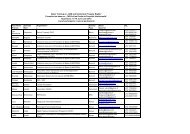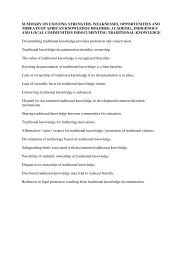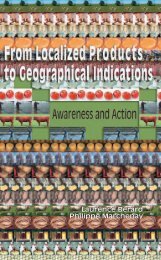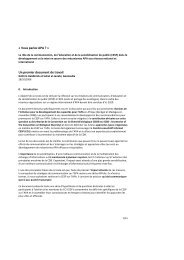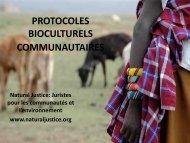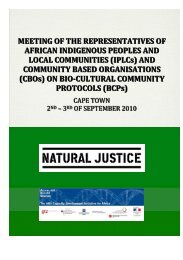The History of Farmers' Rights - Fridtjof Nansens Institutt
The History of Farmers' Rights - Fridtjof Nansens Institutt
The History of Farmers' Rights - Fridtjof Nansens Institutt
Create successful ePaper yourself
Turn your PDF publications into a flip-book with our unique Google optimized e-Paper software.
24 Regine Andersen<br />
custodians <strong>of</strong> the plant genetic heritage and as innovators in agriculture.<br />
Measures to conserve plant genetic resources and the related<br />
knowledge, and to stimulate innovations were therefore seen as essential.<br />
<strong>The</strong>se measures were sometimes addressed in the context <strong>of</strong> rewards<br />
and benefit sharing, as indicated above. However, they were<br />
also deemed important as an independent component <strong>of</strong> farmers’<br />
rights, vital to present and future food security.<br />
• International fund: All parties agreed to establish an international fund<br />
for farmers’ rights which would provide the necessary muscle to reward<br />
and support farmers for their continued contributions to the conservation<br />
and development <strong>of</strong> plant genetic resources for food and<br />
agriculture.<br />
<strong>The</strong>se stand as the foundations <strong>of</strong> farmers’ rights. <strong>The</strong>y represent the fruit<br />
<strong>of</strong> long and complex negotiations, and need to be taken into consideration<br />
when implementing the International Treaty at the national as well as the<br />
multilateral level.<br />
3 Acts <strong>of</strong> legislation and policies on farmers’ rights<br />
Several countries have drafted or adopted acts <strong>of</strong> legislation regarding<br />
farmers’ rights. <strong>The</strong>se are the first examples <strong>of</strong> legislative efforts in this<br />
regard, and as such they are highly pertinent for other states seeking to<br />
implement the International Treaty. <strong>The</strong> lessons from these experiences<br />
may also help the implementing states to improve their policies on farmers’<br />
rights. Some <strong>of</strong> these lessons and the new questions arising from the<br />
experiences with farmers’ rights legislation are indicated in the presentation<br />
<strong>of</strong> literature below. <strong>The</strong>re are in particular two acts <strong>of</strong> legislation that<br />
have been debated in the literature:<br />
• India: Protection <strong>of</strong> Plant Varieties and Farmers’ <strong>Rights</strong> Act (2001, in<br />
force) with the Protection <strong>of</strong> Plant Varieties and Farmers’ <strong>Rights</strong> Rules<br />
(2003, in force)<br />
• Africa: <strong>The</strong> African Union Model Law on <strong>Rights</strong> <strong>of</strong> Local<br />
Communities, Farmers, Breeders and Access (Formally endorsed by<br />
the heads <strong>of</strong> state <strong>of</strong> the African Union in 2000, to be used as a model<br />
for the design <strong>of</strong> national legislation in AU member countries)<br />
In Background Study 2 from the Farmers’ <strong>Rights</strong> Project, which presents<br />
the results from an international stakeholder survey, we have compiled a<br />
range <strong>of</strong> further legislation which our respondents deemed relevant to<br />
farmers’ rights (pp. 18–35). 31 Some <strong>of</strong> these have been adopted, other are<br />
still in draft form at various stages in the negotiation process. <strong>The</strong>y differ<br />
greatly in their approach to farmers’ rights, but it is beyond the scope <strong>of</strong><br />
this report to flesh out their contents and differences further. We also<br />
found that farmers’ rights are being realized through programmes and<br />
policies not covered by specific legislation. Already there are examples <strong>of</strong><br />
realization <strong>of</strong> all components <strong>of</strong> farmers’ rights addressed in the Interna-<br />
31 Some <strong>of</strong> these can be downloaded from GRAIN’s website: www.grain.org/<br />
brl/typeid=45




